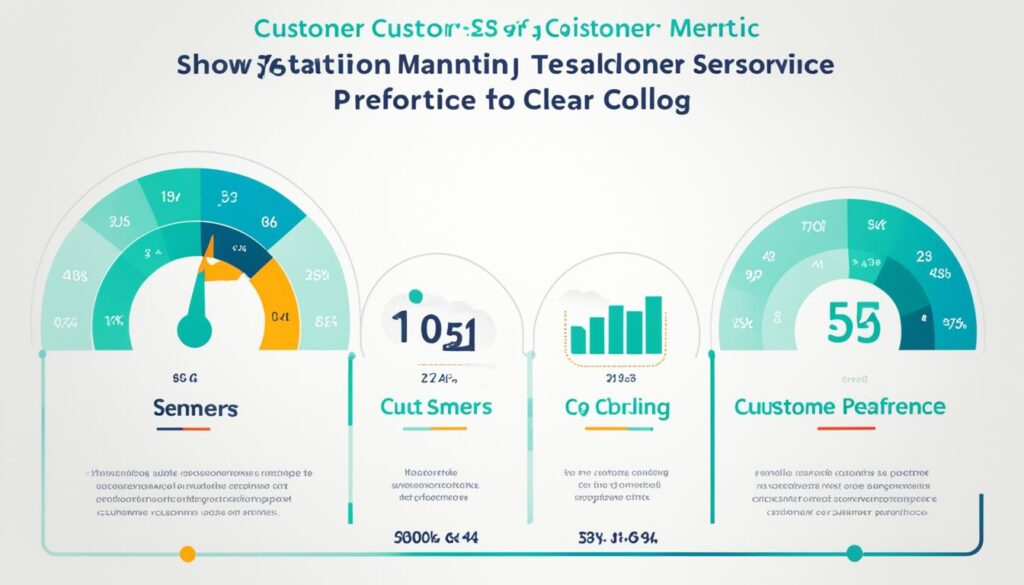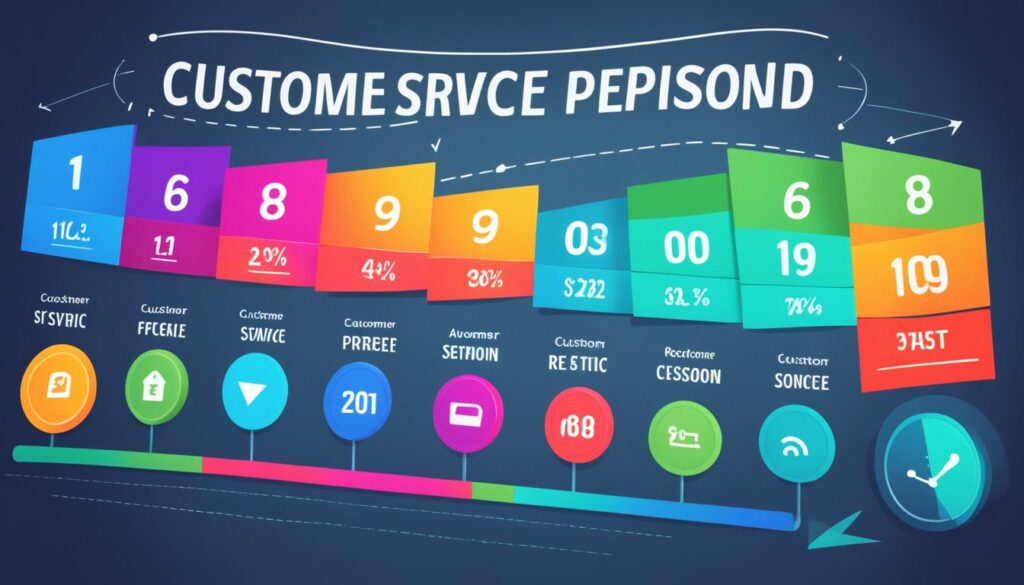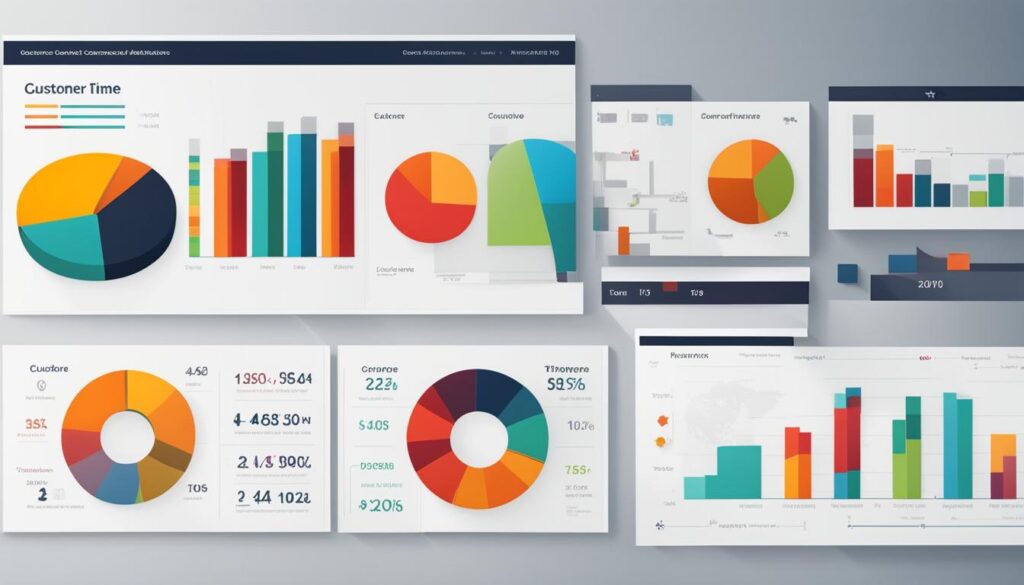Tracking customer service metrics is crucial for improving customer loyalty and your bottom line. There are various customer service metrics that you can use to measure performance, including customer satisfaction (CSAT) score, customer effort score (CES), Net Promoter Score (NPS), social media metrics, churn metrics, first reply time (FRT), ticket reopens, resolution time, agent touches, and tickets solved. By monitoring these metrics, you can gain valuable insights into the effectiveness of your customer service efforts.
Key Takeaways:
- Tracking customer service metrics is essential for improving customer loyalty.
- Customer satisfaction (CSAT) score, customer effort score (CES), and Net Promoter Score (NPS) are important metrics to measure.
- Monitoring social media metrics, churn metrics, and response time provides insights into customer service effectiveness.
- By measuring these metrics, you can identify areas for improvement and optimize your customer service performance.
- Utilize the right tools, such as customer relationship management (CRM) and survey tools, to track and analyze customer service metrics effectively.
Understanding Customer Service Metrics
When it comes to measuring customer service performance, customer service metrics are vital. These metrics, often referred to as key performance indicators (KPIs), allow you to track the satisfaction of your customers and evaluate the effectiveness of your support team.
By understanding customer service metrics, you gain valuable insights into how well your agents are equipped to handle customer queries and how satisfied your customers are with their support experiences. This data enables you to identify areas for improvement and make data-driven decisions to enhance your customer service performance.
Customer service metrics can provide you with a comprehensive overview of your team’s performance and the impact it has on customer satisfaction. Monitoring these metrics allows you to measure the efficiency of your support processes, identify bottlenecks, and implement targeted solutions to improve customer experiences.
Some of the most common customer service metrics include:
- Customer satisfaction (CSAT) score: Measures overall customer satisfaction with your support interactions.
- Net Promoter Score (NPS): Indicates customer loyalty and likelihood to recommend your brand.
- Customer effort score (CES): Assesses the ease of resolving customer issues.
- Social media metrics: Tracks customer sentiment on social platforms and evaluates brand reputation.
- Churn metrics: Measures customer retention and identifies points of friction in the customer journey.
- First reply time (FRT): Determines the speed of initial response to customer inquiries.

When measuring customer service performance, it’s important to choose metrics that align with your business goals and customer expectations. These metrics provide actionable insights that enable you to improve customer satisfaction, optimize support processes, and drive long-term success for your business.
| Customer Service Metrics | Description |
|---|---|
| Customer Satisfaction (CSAT) Score | Measures overall customer satisfaction with your support interactions. |
| Net Promoter Score (NPS) | Indicates customer loyalty and likelihood to recommend your brand. |
| Customer Effort Score (CES) | Assesses the ease of resolving customer issues. |
| Social Media Metrics | Tracks customer sentiment on social platforms and evaluates brand reputation. |
| Churn Metrics | Measures customer retention and identifies points of friction in the customer journey. |
| First Reply Time (FRT) | Determines the speed of initial response to customer inquiries. |
Essential Customer Service Metrics
When it comes to measuring your customer service performance, there are several essential metrics that you should focus on. These metrics provide valuable insights into different aspects of your customer service operations, allowing you to identify strengths, weaknesses, and areas for improvement. By measuring these essential customer service metrics, you can optimize your customer service strategies and enhance customer satisfaction.
1. Customer Satisfaction (CSAT) Score
The Customer Satisfaction (CSAT) score measures the level of satisfaction that customers have with your products or services. It is typically obtained through post-interaction surveys or feedback forms. By tracking your CSAT score, you can gauge how well your customer service representatives are meeting customer expectations.
2. Customer Effort Score (CES)
The Customer Effort Score (CES) assesses the ease of doing business with your company. It measures the amount of effort customers have to put forth to resolve a support issue or complete a transaction. By monitoring your CES, you can identify pain points in your customer journey and streamline processes to reduce customer effort.
3. Net Promoter Score (NPS)
The Net Promoter Score (NPS) is a metric that measures customer loyalty and likelihood to recommend your brand to others. It helps you identify promoters, passives, and detractors among your customer base. By tracking your NPS, you can gauge customer loyalty and assess the effectiveness of your customer service efforts in driving positive word-of-mouth.
4. Social Media Metrics
Social media metrics allow you to monitor your brand’s presence and sentiment on social media platforms. These metrics include the number of mentions, likes, comments, shares, and overall sentiment. By analyzing social media metrics, you can identify trends, engage with customers, and address any issues or concerns in real-time.
5. Churn Metrics
Churn metrics measure the rate at which customers discontinue using your products or services. It provides insight into customer loyalty, satisfaction, and the effectiveness of your customer retention strategies. By tracking churn metrics, you can take proactive measures to reduce customer churn and improve customer retention.
6. First Reply Time (FRT)
The First Reply Time (FRT) metric measures the average time it takes for your customer service team to respond to customer inquiries or support tickets. It reflects your team’s efficiency and responsiveness. By monitoring FRT, you can ensure timely customer support and identify areas where response times can be improved.
7. Ticket Reopens
Ticket reopens refer to the number of times customers need to reopen a support ticket due to unresolved issues or inadequate solutions. This metric indicates the effectiveness of your customer service resolutions. By reducing ticket reopen rates, you can improve the quality of your support interactions and customer satisfaction.
8. Resolution Time
Resolution time measures the average time it takes to resolve customer inquiries or support tickets. It reflects the efficiency and effectiveness of your customer service team. By tracking resolution time, you can optimize workflows, allocate resources effectively, and enhance customer satisfaction by providing timely solutions.
9. Agent Touches
Agent touches refer to the number of interactions or escalations required to resolve a customer’s issue. This metric helps you assess the complexity of customer inquiries and identify opportunities to streamline your support processes. By reducing agent touches, you can improve efficiency, reduce customer effort, and enhance overall customer service performance.
10. Tickets Solved
Tickets solved measures the percentage of customer inquiries or support tickets that are successfully resolved within a specified timeframe. It is an indicator of your team’s productivity and effectiveness. By monitoring this metric, you can identify areas for improvement, allocate resources efficiently, and ensure high-quality support interactions.
To get a comprehensive overview of your customer service performance, it’s important to analyze these essential metrics collectively. By tracking and analyzing these metrics regularly, you can make data-driven decisions, implement targeted improvement strategies, and deliver exceptional customer service.

Tools for Tracking Customer Service Metrics
To effectively track customer service metrics and optimize your performance, it’s important to utilize the right tools. These tools not only simplify the data collection process but also provide insights that can drive meaningful improvements to your customer service operations. Here are some essential customer service tools that can help you measure and analyze your performance:
Customer Relationship Management (CRM) Tool
A customer relationship management (CRM) tool serves as a centralized hub for managing customer interactions and support efforts. It enables you to track and store customer information, set performance goals for your agents, and monitor team progress. With a CRM tool, you can easily gather, analyze, and leverage customer support metrics to evaluate your service levels and make data-driven decisions that improve customer satisfaction.
Survey Tools
Survey tools are invaluable for collecting customer feedback and understanding their perceptions of your service. These tools allow you to create and distribute surveys to measure customer satisfaction, gather insights on specific interactions, and identify areas for improvement. By analyzing the survey results, you can gain a deeper understanding of customer expectations, pinpoint pain points, and tailor your service to better meet their needs.
Social Media Monitoring Tools
In today’s digital age, social media plays a significant role in shaping customer perceptions and feedback. Social media monitoring tools enable you to track brand mentions, customer sentiments, and engage with customers on various platforms. By monitoring social media metrics, you can identify customer issues, respond promptly to queries or concerns, and proactively manage your brand’s reputation.
By utilizing these customer service tools, you can automate the tracking process, gain valuable insights, and continuously measure and enhance your customer service performance. These tools empower you to deliver exceptional support experiences, build stronger customer relationships, and drive positive business outcomes.
The Importance of Measuring Customer Service
Measuring customer service is crucial for various reasons. It provides valuable insights that can drive improvements, enhance customer satisfaction, and boost loyalty. By evaluating key customer service metrics, you can gain a deeper understanding of your customers’ perception of your brand and identify areas where you can enhance their experience.
One of the benefits of measuring customer service is the ability to identify areas for improvement. By monitoring metrics such as customer satisfaction scores, response times, and resolution rates, you can pinpoint specific aspects of your service that may require attention. This allows you to develop targeted strategies and allocate resources effectively to address customer pain points and deliver a better overall experience.
Furthermore, measuring customer service enables you to understand what your customers think of you. By analyzing metrics like Net Promoter Score (NPS) and customer feedback, you can gauge customer sentiment and identify strengths and weaknesses in your service delivery. This information empowers you to make data-driven decisions to improve customer satisfaction and build long-term loyalty.
Another advantage of measuring customer service is the ability to assess how well your support teams are functioning. By tracking metrics such as first response time, ticket resolution time, and agent touches, you can evaluate the efficiency of your support operations. This allows you to identify bottlenecks, streamline processes, and optimize resource allocation to ensure your teams are delivering exceptional service.

By measuring customer service, you can make data-driven decisions to optimize your overall performance. The insights gained from tracking customer service metrics can guide resource allocation, process improvements, and strategic decision-making. This not only improves the efficiency of your customer service operations but also enhances customer satisfaction and loyalty.
In summary, measuring customer service is essential for businesses looking to enhance their customer interactions and drive success. It provides valuable insights that help identify areas for improvement, understand customer perceptions, and evaluate support team performance. By leveraging these insights, you can optimize your customer service operations, deliver exceptional experiences, and build strong customer relationships.
The Top Customer Service Metrics to Measure
When it comes to measuring customer service success, certain metrics provide valuable insights into different aspects of your performance. By tracking these top customer service metrics, you can evaluate customer satisfaction, ease of interaction, loyalty, social media sentiment, customer retention, response time, resolution rate, and overall customer support efficiency.
Customer Satisfaction (CSAT) Score
The CSAT score measures how satisfied customers are with the support they receive. It is typically collected through post-interaction surveys, asking customers to rate their experience on a scale. A high CSAT score indicates happy customers, while a low score highlights areas for improvement.
Customer Effort Score (CES)
The CES metric measures the amount of effort customers have to put into resolving their issues. It focuses on ease of interaction and aims to identify any friction points in the customer journey. A lower CES score indicates a smoother, more effortless experience for your customers.
Net Promoter Score (NPS)
NPS measures customer loyalty and their likelihood of recommending your brand to others. It is based on a single question: “On a scale of 0-10, how likely are you to recommend our company to a friend or colleague?” Customers are categorized into promoters, passives, or detractors, giving you an overall NPS score that reflects their loyalty.
Social Media Metrics
Social media metrics involve analyzing customer sentiment, engagement, and interactions on platforms like Facebook, Twitter, and Instagram. Monitoring social media conversations and mentions of your brand can provide insights into customer satisfaction and help you identify areas where improvements or interventions are needed.
Customer Churn
Customer churn refers to the rate at which customers stop using your products or services. Tracking churn metrics allows you to gauge customer retention and identify factors contributing to attrition. By addressing the root causes of churn, you can reduce customer turnover and increase loyalty.
First Response Time
The first response time metric measures how quickly your support team responds to customer inquiries or issues. A shorter first response time indicates prompt and efficient customer service, while a longer time may lead to frustration and dissatisfaction.
Overall Resolution Rate
This metric determines the percentage of customer issues that your support team successfully resolved. A higher resolution rate suggests effective problem-solving skills, reflecting positively on your customer service performance.
First Contact Resolution Rate
The first contact resolution rate indicates the percentage of customer issues resolved during the initial interaction. A higher rate suggests that your support team has the knowledge and resources to address customer concerns promptly, resulting in a smoother customer experience.
Customer Ticket Request Volume
The customer ticket request volume metric measures the number of support tickets or requests your team receives within a given period. This metric helps you understand customer demand and workload, allowing you to allocate resources effectively and improve response times.

By tracking these top customer service metrics, you can gain a comprehensive view of your performance and identify areas for improvement. Use these insights to optimize your customer service strategies, enhance customer satisfaction, and boost loyalty, leading to long-term business success.
Achieving Success in Customer Service
To achieve success in customer service, it’s crucial to take a holistic approach that combines various measurement strategies and metrics. By adopting a data-driven approach and leveraging customer service metrics, you can continuously enhance your performance and deliver exceptional support experiences to your customers.
One essential aspect of measuring customer service effectiveness is monitoring operational data. By tracking metrics such as first response time, overall resolution rate, and first contact resolution rate, you can identify areas for improvement and optimize your team’s efficiency.
Furthermore, experience data plays a vital role in understanding customer satisfaction and loyalty. Metrics like customer satisfaction score (CSAT), customer effort score (CES), and Net Promoter Score (NPS) can provide valuable insights into your customers’ perceptions and their likelihood to recommend your brand.
Lastly, gathering customer feedback through surveys allows you to directly understand their needs, preferences, and pain points. By regularly collecting and analyzing customer feedback, you can make data-driven decisions, identify trends, and implement changes that align with your customers’ expectations.
FAQ
Why is it important to measure customer service performance?
Measuring customer service performance is crucial for improving customer loyalty and your bottom line. It allows you to identify areas for improvement, understand customer sentiments, and make data-driven decisions to enhance your customer service efforts.
What are customer service metrics?
Customer service metrics are key performance indicators (KPIs) that help you track the satisfaction of your customers and the performance of your support team. These metrics provide insights into how well your agents are equipped to do their jobs and how happy your customers are with their support experiences.
What are some essential customer service metrics?
Some essential customer service metrics include customer satisfaction (CSAT) score, customer effort score (CES), Net Promoter Score (NPS), social media metrics, churn metrics, first reply time (FRT), ticket reopens, resolution time, agent touches, and tickets solved.
What tools can I use to track customer service metrics?
To effectively track customer service metrics, you can use customer relationship management (CRM) tools, survey tools, and social media monitoring tools. These tools help you gather, analyze, and leverage customer support metrics, allowing you to make data-driven decisions and gain valuable insights into your customer service performance.
Why is measuring customer service important?
Measuring customer service allows you to identify areas for improvement, understand customer expectations, and evaluate the performance of your support teams. It helps you enhance the quality of customer interactions, increase satisfaction and loyalty, and make data-driven decisions to optimize your customer service performance.
What are the top customer service metrics to measure?
The top customer service metrics to measure include customer satisfaction (CSAT) score, customer effort score (CES), Net Promoter Score (NPS), social media metrics, customer churn, first response time, overall resolution rate, first contact resolution rate, and customer ticket request volume. These metrics provide valuable insights into different aspects of your customer service performance.
How can I achieve success in customer service?
To achieve success in customer service, it’s important to adopt a holistic approach that combines various measurement strategies and metrics. This includes monitoring operational data, experience data, and customer feedback through surveys. By making data-driven decisions and leveraging the insights gained from customer service metrics, you can continuously enhance your customer service performance and drive positive business outcomes.
